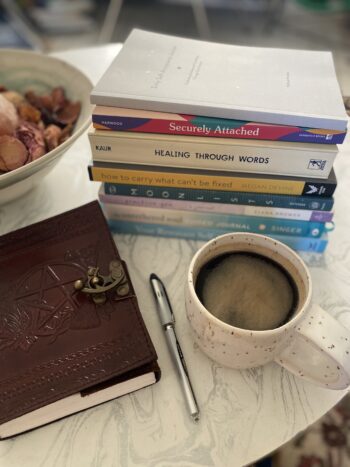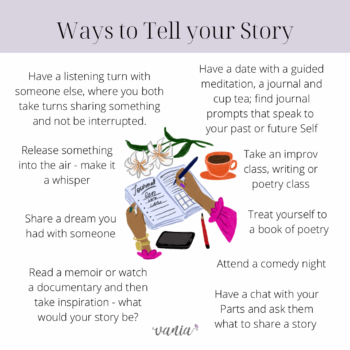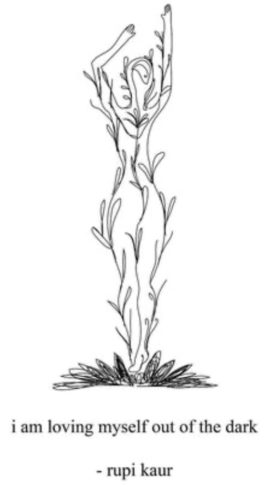We are in the season of Spring where i live, which is represented by the element of Air. This is the time of new beginnings, the fresh air of change, the rebirth and the sunrise as a new dawn. Air is connected to the suit of swords in Tarot, which are all about action, ambition, courage and change. Air is also magical for the speaker and listener. We use our words, and repeat them into the air by casting a spell with our words. When we speak out loud what we want, we are in fact speaking our truth more assertively and intentionally.
Storytelling is one of the oldest and most universal forms of community-building. We are not meant to tell stories alone, they are meant to be shared. And, since we are social creatures, we heal in healthy relationships. I view storytelling as a resource for healing, growth and transformation. Integration and acceptance of a new life transition or realization cannot truly happen without being witnessed and companioned through it. Stories are meant to be shared with listeners who hold space for the story and teller, both. This form of holding space ultimately becomes a catalyst to be more fully actualized as ourselves.

Here are some ways that i have found being a story listener to be a central piece in how i work and hold space as a psychotherapist. As a psychotherapist who works from a feminist, narrative framework, story-telling and listening, as well as holding space is a big part of the alchemy that happens in my therapy sessions. Feminist Narrative Therapy is a post-modern modality of therapy that is based in a deeper connection to the subjective meaning that is typically lost in everyday conversations.
Talk therapy gets a bad wrap and yet I’ve noticed that it is through speaking out loud that we get the opportunity of integration that helps our cognitive parts understand the information we receive from our body. We need to talk in order to process the work of everyday life. It is a balance of both/and of talking and doing. We offer this integration after major trips and pilgrimages, or a psychedelic immersion. Birth story processing is a key resource to help folks heal from birth trauma. Sometimes the experience is quiet reflection alone, or in a journal, but it is typically recapping or debriefing the story that unfolded regardless.
I used to work as a front-line crisis counsellor for folks who experienced gender-based violence. One of the strongest messages in the gender-based violence sector is that ‘your silence will not protect you.’ These powerful words by Audre Lorde are a direct proclamation of the power of healing that can happen when we share the truth of our lives. We also now know that we do not need to in fact go over our past traumas in chronologically story-book form in order to heal them. This is not how healing works, and yet when a person wants to be witnessed in their resilience and strength, that is also a powerfully catalyst to get to heal. One of the programs that i was most honoured to organize was an annual gathering for the people we supported. We would spend the day together, in workshops and intentionally sharing stories of healing and resilience. One of the stages of Post-Traumatic Growth is to share our story as a way to heal, and to also be an inspiration for others.
Stories help heal shame, as it is in the shared experience and common humanity that we offer a balm to shame, which would otherwise thrive in isolation. I have found this especially empowering for the people i support who may carry limiting beliefs about themselves, their bodies, or how they gave birth, or the break-up or break-down they experienced.
Some stories do not have to be real to be impactful. They jut need to be relatable in some way.
Archetype stories have become a special kind of steward for me, in so many ways – when i became an adult, a mother, and also in the years since becoming motherless. Now, as i surrender to perimenopause i am once again reading the feminine-based archetypal stories that feature wise women, medicine women, wild women, hags and crones. Myths and fairy/folk tales offer a universal truth for all of us, as well as a map that is possible for us. Any one of us can read the story and glean something that is familiar in it that reflects our own lived reality. This is comforting and affirming.
Marion Woodman was a great advocate for archetypal stories. In her book The Maiden King she shares this: “Our bodies love metaphors because they join our bodies to our soul rather than abandoning them to a soulless state. The ancient alchemists called this body soul state “the subtle body”. They believed that the deeper we go into the subtle body, the greater the soul treasures it contains.” I would take this point a step further and connect it to how stories in general are a way to deepen our relationship with our soul. If you have ever been in my therapy room with me, you will know that i love to share a good story as a metaphor as a way to explain a theory or experience.
Just as we are not meant to be alone with a story to tell, so too are we not meant to be alone in our grief. Transformation can happen for grievers when they are able to share these stories with someone who holds space for them, and both welcomes and encourages the stories to flow. This is done through the power of storytelling.
When my mom died, something that i found so kind and generous was when people in my life asked me to talk about her, to share her stories, to honour her legacy. In my own therapy practice, i offer grief work and tending to the broken hearts of someone who has experienced loss. I see how transformative this dedicated time is in the healing journey. It is through the process of being seen and heard that anyone who is grieving a loss can feel more held and less alone. Incorporating narrative in this stage is a helpful way to establish a more full sense of self.
Taking this a step further, when people are given an audience that is both compassionate and attuned, links can be made to the story and to their own life. For instance, I have found solace in cleaning out my mother’s things. Being able to share the experience of cleaning out my mother’s belongings is a universally understood rite of passage. We are not meant to do it alone, even if the act itself is a solitary process. Friends who asked me more than the standard “how are you?” received a more full and true account of my learnings and discoveries.
Not only was my grief more held, it was in the telling of the stories that i was able to come alive amidst my mourning. I was also able to truly express what i was going through, in detail. This invitation offered depth and spaciousness for me to debrief, unpack, and process what i was encountering in my grief.
No one is fully prepared for the time that their mother dies, no matter how expected it is, nor if the griever is a therapist herself, well-versed in holding space in grief counselling. I had to find the right balance between my personal grief process and my role as a psychotherapist who is well-versed in the healing balm of storytelling.
Where does the listener turn when she needs to be held and companioned through her own loss?
As we see in Rites of Passage theory, it is necessary to be witnessed in the transition from one version of us to a new sense of self. This is in fact, a way that we can move through the process of a rite of passage such as mother loss. Being witnessed in this transition is what can deepen the healing process, and in fact get to a more transformed and integrated sense of self.
In these dark and painful times, i’m turning to fantasy novels as support, solace, and sisterhood. For instance, in Starhawk’s novel Walking to Mercury, she shares that the healing that happens from ritual isn’t necessarily the trance work, drumming, dancing or singing that helps. “What healed was simply the opening to speak their pain and have it heard.”
I am working on ways to decolonize my therapy practice and life in general. In Dr. Jen Mullan’s book, Decolonizing Therapy, she shares powerful insights and guidance on how to shift from a western capitalist model to one that is more holistic and person-centred. As i deepen into my own process, i am reclaiming trust in my ability to bring in more a psychospiritual lens. While therapy is not inherently a ritual, we can infuse ritual into our work together. ((Stay tuned to my next journal article where i share some of the ways i do just that.)) ETA: Immediately after i posted this, i saw someone i deeply admire also share that “ritual is the original therapy.” One of the most beautiful experiences to witness is the shift folks experience when they sit in session and have someone who holds unconditional regard, a compassionate and non-judgemental stance, and also undivided attention for their story. This is what we call relational alchemy. The ultimate gift is witnessing someone transform and i am given the opportunity to experience vicarious resilience.
I see my therapy practice more and more like a ceremony. It is not mere work, transactional at best or hurtful at worst. Having a “career” is capitalist after all (thank-you Dra. Rocio for this reframe). Sitting together and sharing breath in the same room is a ceremony webbing the invisible golden thread of co-regulation, attunement and medicine between us, through us, and around us. Therapy is a prayer. It doesn’t have to be with another person; it is a catalysing moment that deepens our healing and transforms it. It just needs words spoken in some way to create that shift.
Healing requires recovery, and it is a life-long journey to heal. Not because we are incapable of doing it better. Rather, new experiences can activate what felt healed in the past and is now being brought back up to the surface, but in a new way. For instance, maybe as a child you were not listened to. Maybe you were never asked to share your dreams or hopes, or what imaginative stories were. Growing up, we then internalise the story literally – that what we have to share is not worthy to be heard by others. The story isn’t the only thing that can be silenced – our dreams and self-worth also are threatened to die inside us.

Therapy can be an alchemizing experience where clients are reborn, birthing their healed self from the embers of a former life. Therapists are the doulas who support their clients in this transition of becoming. When we share how we are feeling or what we need, we are being authentic to ourselves. This level of witnessing or experience and listening with attention also lets us know that we exist and we matter. When we stop speaking up for our feelings and needs, we suffer a level of self-abandonment, and also possibly a true death.
I know this might seem dramatic. And yet I sit with this truth that my mom died because of complications of undiagnosed ovarian cancer. The story she was sharing for so long was that her stomach hurt. I know that this was a complaint, and I also know that no one really took it seriously, including myself. If only someone had listened sooner, I know things would’ve been different.
As a feminist therapist, one of our principles is to self-disclose from our lived experience. We don’t share where the wounds are still raw, but where the scars have healed over. Sharing stories can also be so affirming, empowering and inspiring for the folks that I give this medicine to. This shared humanity experience can further fuel their own motivation. Knowledge is Power and sharing resources is also a Feminist principle.
Another aspect of the therapeutic container is that the therapist becomes an active listener to someone’s story, with undivided attention and a very present attention. This then becomes a Reparative Experience – we are given the healing balm of being heard and listened to, and not carrying the fear of being too much, as we possibly once believed. So many of us, especially women, mothers, and life-long care providers are starving for the attention to be seen and heard as well. This may be a band-aid to a larger problem, the mental health and therapy industrial complex exists as an imperfect solution to a lack of strong community and connection. And yet, as we can practice repair work, earning secure attachment, and healing relational wounds in the therapy space, for now this is a solution that works.
The therapeutic relationship offers more than psychoeducation and passive listening. It also is a space for tender acts of affection, and vulnerability by wearing our hearts on our lab coat sleeves now and then. A compassionate witness and true space holder listens with reverence. Having a place to reflect and unpack can be alchemical.
At least for me, it is more than just a couch and a quiet nod. I get right into your story, and get comfy in my chair or on the floor right beside you.


